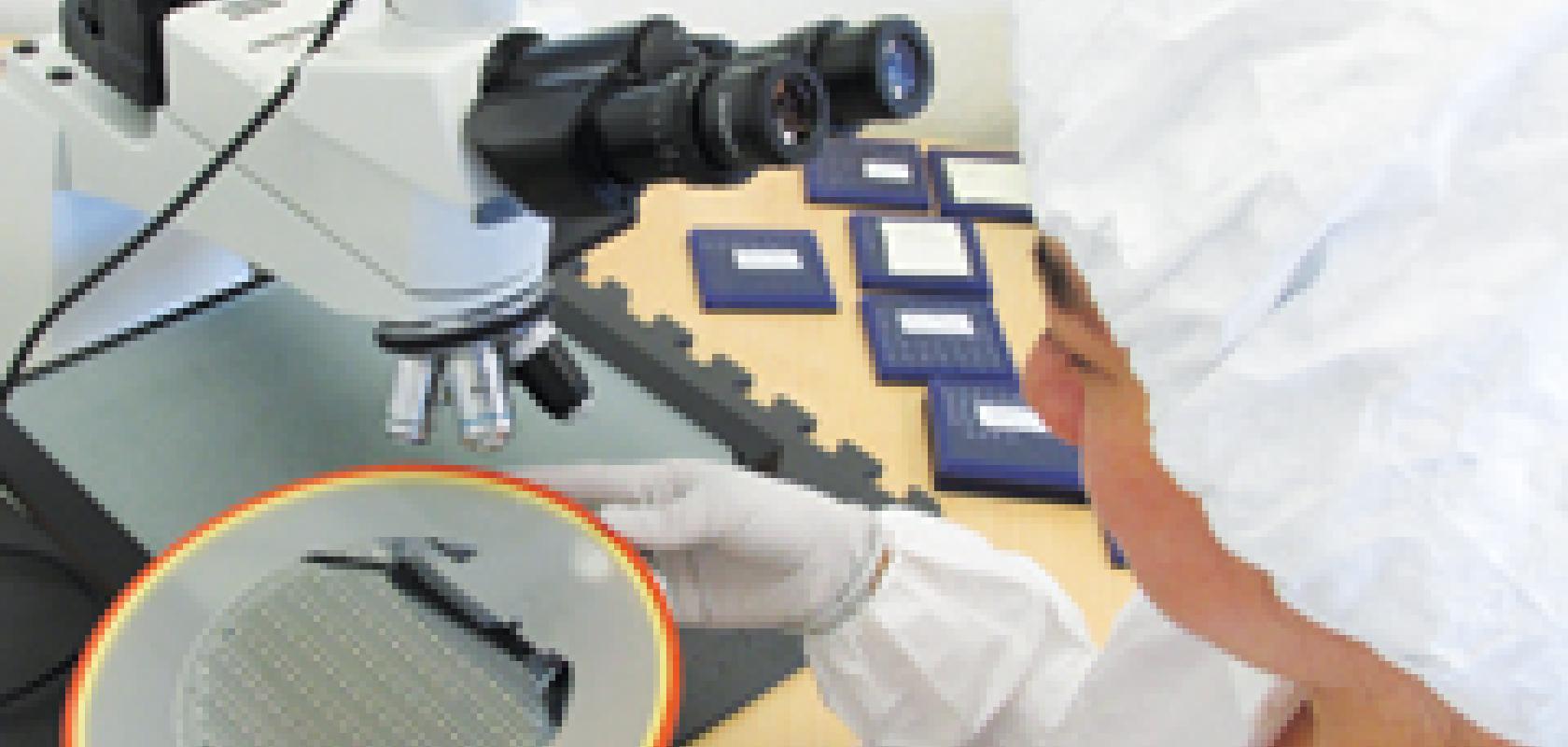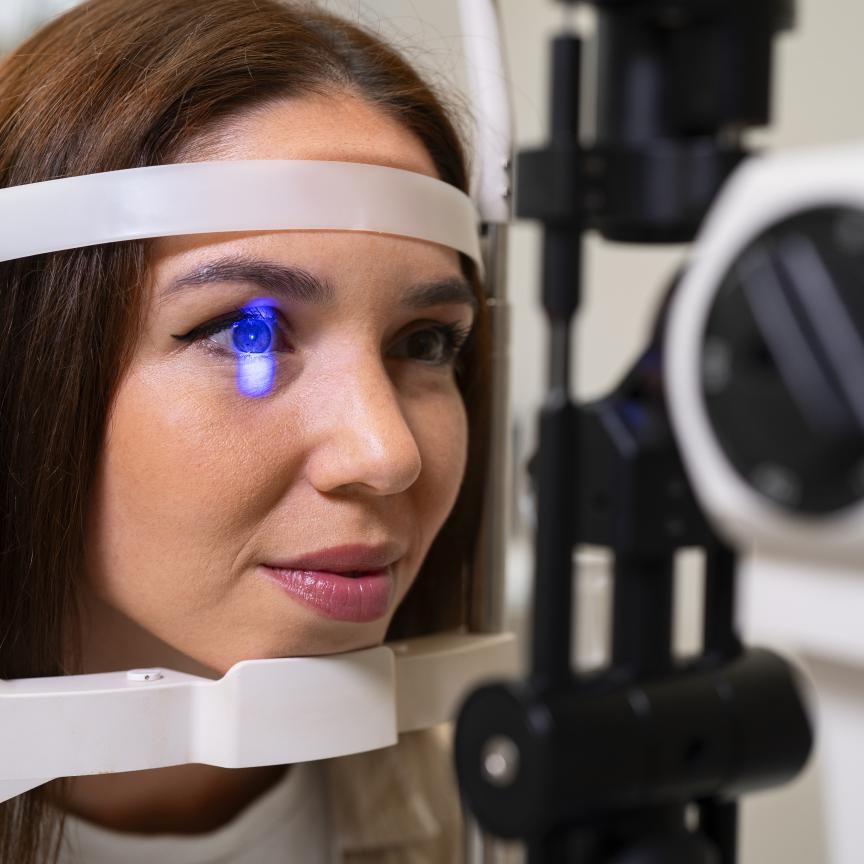A consortium of researchers in Vienna is developing a chip-based optical coherence tomography (OCT) system that could enable pocket-size devices. The project, which is being funded by Horizon 2020, aims to make OCT instruments far less expensive and more compact than current desktop systems. This could open up the technology to countries that don’t have good access to OCT and thereby improve screening for retinal diseases.
In the field of ophthalmology, every second person having an eye test receives a regular OCT scan, and although current systems are high quality, they are sometimes impractical to use. ‘Yes, there are a lot of OCT systems sold, but they’re bulky, they have to be maintained, there’s a lot of maintenance cost and time, and they cost around €50,000 to €120,000,’ said Wolfgang Drexler, head of the Centre for Medical Physics and Biomedical Engineering and leader of the H2020 project at the Medical University of Vienna. ‘Our technique is looking very promising in overcoming each of these issues.’
The €4.9 million funded project began six months ago in January and will run for five years. Drexler and the consortium are taking advantage of recent advances in silicon photonics to reduce the size of OCT technology and integrate it onto a chip. The system being developed is suitability named the OCTCHIP, and will be far less expensive and more compact than current OCT systems.
‘OCTCHIP is really targeting ophthalmic OCT,’ said Drexler. ‘So the idea is that we have not only miniaturised the optics, but also miniaturised the electronics, detector and light source to package it ideally to the size of a one cent coin, which is 15mm in diameter.’ The consortium is able to achieve this because of the simplicity of the optics. ‘Once you have the optic waveguide design, with minimal losses you can really make the size much smaller,’ said Drexler. ‘Therefore, you can envision some kind of wafer that is 10-20cm in diameter, and there can be hundreds of OCT systems on it.’
The research being conducted by the consortium aims to eliminate the less desirable characteristics of OCT systems. ‘We have planned for the OCTCHIP not only to be much smaller, but also three to five times cheaper, and four times faster, than current systems,’ stated Drexler.
According to Drexler, once the system has been properly designed, manufactured and fabricated on a chip, packaged and the electronics added, the system will be almost completely maintenance free.
The reduced price and maintenance requirements of the OCTCHIP make it very appealing to areas of the world that do not currently have access to OCT technology. Its small size will be essential for transportation and practicality in these areas. ‘You could think of some kind of very compact and ultimately prominent OCT handheld system… you can go to developing countries where they cannot afford a €50,000 to €120,000 machine,’ continued Drexler.
In addition to a handheld device, Drexler has envisioned multiple other uses of these chip-based systems. ‘I think first I see this in supermarkets as a screening tool because it’s cost effective.’ Customers doing their shopping could potentially be screened for diabetes, which an OCT eye scan can diagnose, or a retinal disease, according to Drexler. ‘Those who are involved in telemedicine can have this [technology] at home. You would put some goggles on each day and send information to your doctor,’ he added.
Borrowing from telecoms
‘Photonic integrated circuits and the advances pushed by telecom and biosensors have led to microelectronics and complicated semiconductor-based light sources that you can nicely integrate onto a chip,’ explained Drexler. In doing this, however, limitations arise that prevent smaller OCT systems from producing images that are as high quality as their larger modern counterparts. ‘With fibres [used in telecoms] you achieve very small losses over kilometres; here you have to bring down the losses over millimetres,’ said Drexler.
In the telecoms industry any signal losses are compensated for by very high power light sources. However, applying this to OCT would not be a solution as, according to Drexler, the signal that comes back from the eye tissue is too weak, when it passes to the detector, to produce a high quality image.
So, developing a handheld OCT device will result in compromises to the retinal image quality. ‘The image quality always depends on the size of the optics,’ explained Dr Nishant Mohan, director of product management and marketing at Wasatch Photonics, a provider of OCT systems. ‘Similar to traditional photography – where cameras have been miniaturised to fit on a mobile phone – although at a cost of performance and flexibility, a smaller system is likely to result in compromises in performance as well.’
Smaller optical devices will not be able to match the imaging quality of their larger counterparts until further advances in photonics have been made. ‘At the moment, it would be a huge challenge to get an OCT system on a chip to perform at exactly the same level as a desktop system,’ confirmed Drexler.
To produce a high quality image while still being practical enough to transport and use in multiple locations, researchers could instead look to develop a ‘medium-sized’ OCT device. ‘A system could be the size of a briefcase for a doctor to be able to carry to a different location; it probably doesn’t need to be pocket-sized,’ said Mohan.
However, this solution might not be enough to convince medical professionals to switch to smaller OCT systems. Doctors want the highest quality equipment in their practices to give good diagnostic data. This does create an issue for researchers such as the consortium led by Drexler, who are looking to reduce the size of medical technology, but at a cost of lower image quality. ‘The most brutal customers are doctors. They don’t care how large or small it is. If we don’t solve these issues, it will be a compact, handheld, but diagnostically useless instrument, and doctors won’t be interested,’ said Drexler.
In order to justify the developments of smaller OCT systems, researchers like those in the consortium led by Drexler are targeting new markets for the technology. This is one of the reasons why the project has been chosen for funding by Horizon 2020. ‘The economic impact, which is very important for Brussels in this European project, is that you can think of completely new markets that you can enter,’ explained Drexler.
An affordable handheld OCT device would enable ophthalmic data to be collected in less developed areas of the world, where modern OCT technology is too expensive to obtain. One possibility in these countries is telemedicine, which involves sending data to a specialist via Bluetooth-based, wireless technology in order to get an immediate diagnosis. OCT technology is urgently sought in less developed countries as a diagnostic tool for diseases like diabetic retinopathy, age-related macular degeneration and glaucoma, which are the leading causes of blindness around the world. According to Drexler, the number of cases of diabetic retinopathy, in particular, is increasing in some countries because of unhealthy diet.
Even in developed countries that already possess modern OCT technology, smaller devices will be preferable to a desktop system in certain situations. ‘There are a lot of elderly people who cannot go to a doctor for a diagnosis or have an ophthalmic screening because they’re not mobile enough,’ said Drexler. With a handheld device, doctors could go directly to the patient in their home to make a diagnosis there. ‘The same applies for newborn children... there is a large spectrum of possibilities that might be enabled by this handheld device,’ continued Drexler. Even with an extensive range of potential applications, though, smaller OCT systems will not be desirable in clinics and hospitals until they can compete with the quality of larger desktop systems.
In order to raise the OCTCHIP’s image quality, the consortium needs to overcome the limitations that arise at the smaller scale. ‘If we don’t significantly bring down the losses on the chip… it will be a cheaper, smaller version of OCT technology, but it will be of no use,’ Drexler commented. The consortium therefore needs to overcome this signal loss in order to increase the quality of the OCTCHIP. ‘It’s really scalable to a point where once you bring down the losses, you can design it even more towards higher performance,’ said Drexler. ‘I think it’s just a matter of time before we have the same or even better performance than current systems,’ he added. According to Drexler, this will initiate a kind of paradigm shift in the way OCT is seen. ‘Other techniques will be affected too. I think there’s a lot you can exploit or disseminate out of this technique, but we still have to solve certain issues that are quite challenging,’ he said. Drexler estimated that the world could be seeing smaller, fully functional OCT systems in the next three to five years.
Mirrorcle Technologies is aiding in the reduction in size of OCT technology by supplying components that are enabling smaller systems. ‘Mirrorcle has been offering very compact, dual-axis optical beam-steering solutions for more than 11 years, and shipments to OCT manufacturers have been steadily increasing over the past few years,’ said Dr Veljko Milanovic, CEO of Mirrorcle Technologies.
Mirrocle also provides its dual-axis MEMS mirrors, which offer a compact scanning solution for OCT products. Components such as these are already being integrated into the smaller tools currently used in OCT procedures. ‘Both MEMS mirrors and MEMS controllers… are being deployed in a number of commercially available handheld OCT probes,’ said Milanovic. Although compact, these components are still not small enough to enable independent miniaturised OCT systems. Wasatch’s Mohan explained the reason why products like the OCTCHIP are still years away from being commercialised: ‘Not every photonic component used in OCT is currently mature enough to be put on the chip. One challenge would be to make sure photonic components have the same or similar performance on the chip as they do off the chip. That’s the main technical challenge right now.’
According to Milanovic, the reduction in the size of optical technology is a trend occurring across the medical market. ‘In recent years…we have experienced an increasing influx of potential customers that are interested in more compact biomedical imaging solutions,’ said Milanovic. ‘As for new development for even smaller future OCT systems, we are currently partnering with Microchip Technology to integrate most of our MEMS driver into a single integrated circuit, which will enable further miniaturisation.’


